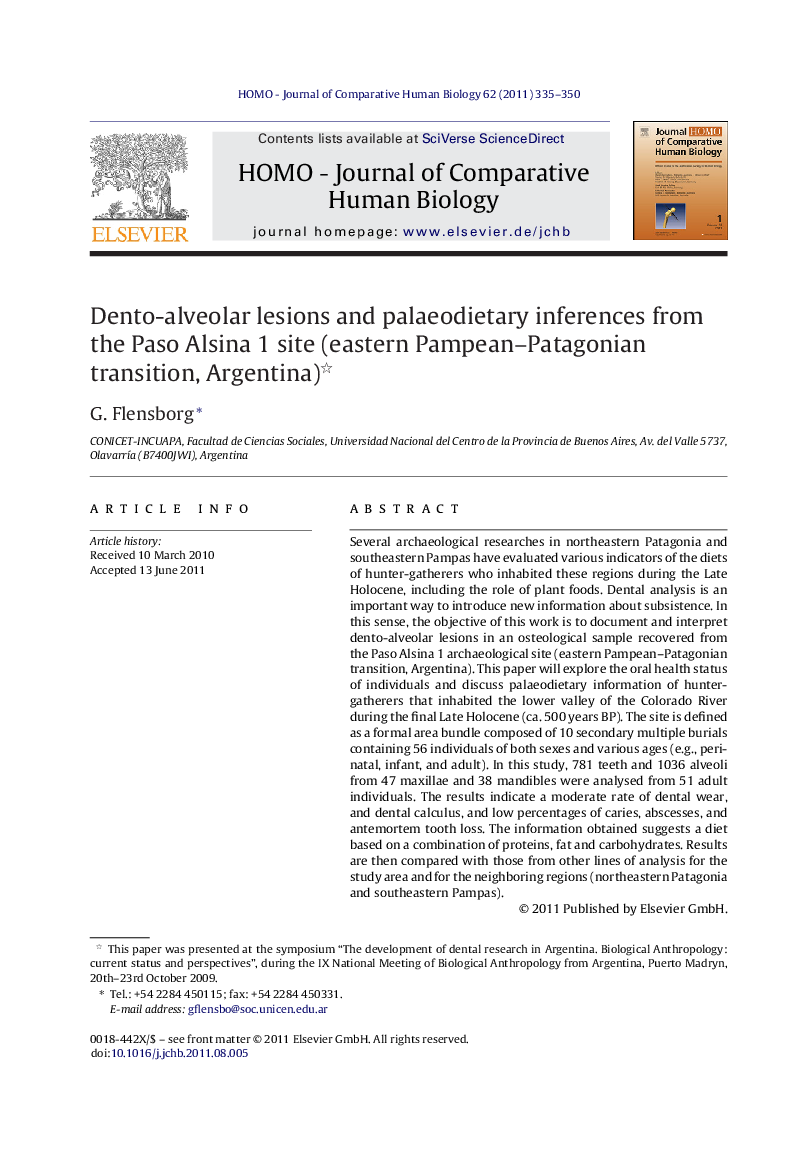| Article ID | Journal | Published Year | Pages | File Type |
|---|---|---|---|---|
| 100493 | HOMO - Journal of Comparative Human Biology | 2011 | 16 Pages |
Several archaeological researches in northeastern Patagonia and southeastern Pampas have evaluated various indicators of the diets of hunter-gatherers who inhabited these regions during the Late Holocene, including the role of plant foods. Dental analysis is an important way to introduce new information about subsistence. In this sense, the objective of this work is to document and interpret dento-alveolar lesions in an osteological sample recovered from the Paso Alsina 1 archaeological site (eastern Pampean–Patagonian transition, Argentina). This paper will explore the oral health status of individuals and discuss palaeodietary information of hunter-gatherers that inhabited the lower valley of the Colorado River during the final Late Holocene (ca. 500 years BP). The site is defined as a formal area bundle composed of 10 secondary multiple burials containing 56 individuals of both sexes and various ages (e.g., perinatal, infant, and adult). In this study, 781 teeth and 1036 alveoli from 47 maxillae and 38 mandibles were analysed from 51 adult individuals. The results indicate a moderate rate of dental wear, and dental calculus, and low percentages of caries, abscesses, and antemortem tooth loss. The information obtained suggests a diet based on a combination of proteins, fat and carbohydrates. Results are then compared with those from other lines of analysis for the study area and for the neighboring regions (northeastern Patagonia and southeastern Pampas).
ResumenLas investigaciones arqueológicas en el noreste de Patagonia y sudeste de la región Pampeana han evaluado varios indicadores referidos a la dieta de los grupos cazadores-recolectores que habitaron estas regiones durante el Holoceno tardío, incluyendo el rol de las plantas. Teniendo en cuenta que los análisis dentarios permiten generar información respecto de la subsistencia, el objetivo de este trabajo es documentar e interpretar lesiones dento-alveolares en una muestra osteológica recuperada del sitio arqueológico Paso Alsina 1 (transición pampeano-patagónica oriental, Argentina). Este trabajo explora el estado de salud oral de los individuos y discute información paleodietaria de los grupos cazadores-recolectores que habitaron en el valle inferior del río Colorado durante en Holoceno tardío final (ca. 500 años AP). El sitio es un área formal de inhumación compuesto por 10 entierros secundarios múltiples y representado por 56 individuos de ambos sexos y diferentes edades (e.g., perinato, infante y adulto). Se analizaron 781 dientes y 1036 alvéolos de 47 maxilares y 38 mandíbulas pertenecientes a 51 individuos adultos. Los resultados indican una moderada tasa de desgaste dental y de cálculos dentales, y bajos porcentajes de caries, abscesos y pérdidas antemortem. La información obtenida sugiere una dieta basada en proteínas, grasas y carbohidratos. Los resultados son comparados con otras líneas de análisis del área de estudio como también de regiones vecinas (noreste de Patagonia y sureste de región Pampeana).
